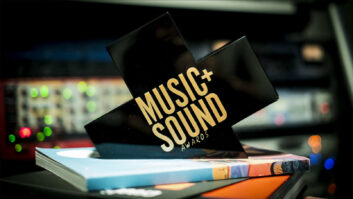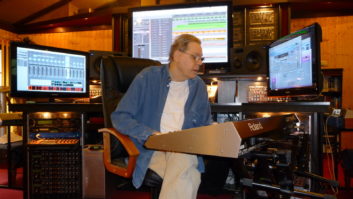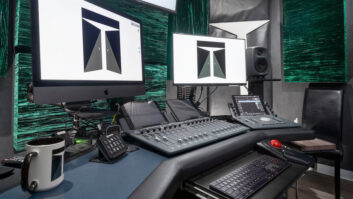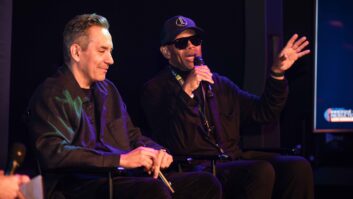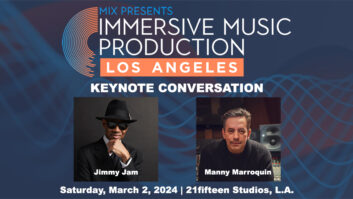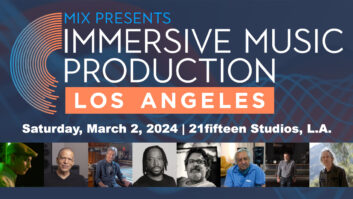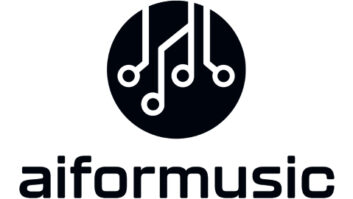
Having built a successful career as a record producer since the late 1980s, California-based Michael James has gone on to become one of the music industry’s most prolific producer/mix engineers. Always driven, James mixes around 250 songs per year, but recently pivoted from his ‘day job’ to create Marchesano—a deeply personal and introspective collection of instrumental, guitar-driven tunes that is a feast of tone and style. Pro Sound News caught up with James at the end of one of his busy mix sessions to talk about making music from the inside out.
ON HIS FIRST BREAK:
When I was about 26, I got the keys to a studio called Radio Tokyo in Venice, CA. I had the place from midnight to 8 a.m. and then would attend classes at UCLA. Around then, a New York band called Too Much Joy came in. They were basically touring so they could record at this studio, which was a mecca for bands like The Minutemen, The Bangles, Jane’s Addiction and a bunch of other up-and-coming L.A.-based bands. On one of the sessions, I was asked to do overdubs. I did the session, kept my mouth shut, got good sounds— and then in the 11th hour, the band was stuck on an arrangement and turned to me and said ‘What do you think?’ I gave them my opinion, and then everything just fell into place and the session got a new lease on life. One thing led to another, and as fate would have it, I ended up producing the album. It received a very favorable review in Rolling Stone, and all of a sudden, I was a producer overnight.
ON MARCHESANO:
This album is named after my family name, and I ended up doing it in part because of the guitar amplifier manufacturer Mesa Boogie. I started using their amps in 1982 and they eventually they took me on as the fifth Mesa Boogie endorser. Frequently, while I was testing their amps, I would play a guitar part through a new amp, then send the clips to Mesa so they could use them online so customers could select the sounds they liked. After doing a lot of this, the president of Mesa called me up and said, ‘Look, dude, you’ve got to put an album out.” I said, “No, I don’t; I’m 50 years old and I don’t want to get in a van and tour.” He told me that every time they put up a clip on his site, the phones would blow up. After thinking about it, I realized it made sense, because I do have something to say. So I did an album and agreed to use a different Mesa amp for each song. I wanted the melodies to reflect the things that were going on in my head and take listeners on a journey
ON SONG SHAPING:
I started writing new compositions that were in part inspired by the way certain guitars and amps made me want to play. If you were to play a Boogie with too much gain, for example, it could change the whole flavor of a song. As I really got rolling with it, I started thinking of the titles of the songs, each being based on something about me, or the way that I live my life. Then I would ask myself ‘What is the melody that I feel goes with the title?’ I would demo the songs by just singing it into the voice memo app on the iPhone, making these sounds that were only decipherable by me. A lot of the stuff that came out of these exercises was unique. But then there were a couple of bits and pieces left over from earlier sessions I had where I contributed certain parts to tunes. For example on “Love Is The Spirit of Life,” the claw picking came from a 2005 performance, but I used it in a completely different musical context. So the album is kind of a decoupage. As far as the textures were concerned, I made a couple of rules going into it: I wanted my guitar parts to be loud and proud, not ‘tucked into the mix’ and not lathered with reverb in delay. I felt like if John Coltrane was playing guitar now, in 2015, how upfront would he want his guitar in the mix?
ON COLLABORATION:
Most of the credited engineers were my friends already, people with whom I wanted to work. It was important for me to have that outside perspective. When I played the guitar part, I said everything I needed to say. But I didn’t want to mix the tunes, and I didn’t want to play any other instruments. So by the miracle that we call the Internet, I was able to have some remote contributors on this project. For example, the drummers each brought their own thing. Some of these were guys that I would send a tune to and say ‘Hey, can you play new drums over this?” They would listen to the click, listen to what I played, and the next day they would send back their edited versions. But it wasn’t just about getting a drum part, it was about getting their perspective; I really wanted this to be a collaborative effort.
ON LINER NOTES:
Liner notes are very important to me, and the reality these days is that there are no liner notes. Pretty soon, there may be no physical product. On my album, I tried to crack the code and figure out a way that was sustainable to do liner notes. So in the physical CD packaging of Marchesano, there is a reference to more detailed liner notes on my site. The point is that people who don’t buy the physical product should not be penalized for not buying it. All the credits are on the physical CD, but the behind the scenes material is all online.
